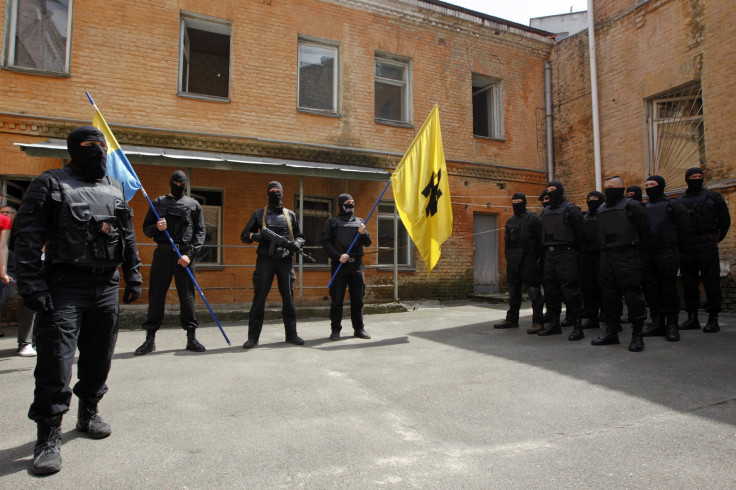Ukraine Crisis: Are Nazis And Nationalists Popular in Ukraine?

Every few weeks, photos and video of ultranationalists displaying Neo-Nazi symbols surface out of Ukraine, showing the world a troubling faction among pro-government elements in the ongoing conflict with pro-Russian separatists. Most recently, stills from a Norwegian television report show two soldiers of the volunteer Azov battalion displaying a Nazi swastika and Nazi “SS runes,” raising new questions about what role nationalism –and to a lesser degree, Nazism- is playing in the Ukraine crisis.
Radical nationalist right-wing groups are minorities in Ukraine, but it's not surprising that men marching in all black and banners eerily similar to the Nazi swastika have attracted international attention. Pro-Russian media anchor much of their criticism of Ukraine's new government, led by President Petro Poroshenko, and its military on Ukrainian nationalist elements, rarely shying from decrying protesters as fascists, Nazis and anti-Russians bent on eradicating ethnic Russians from Ukraine. By keeping the focus on the ugliest and most polarizing elements of the pro-European camp, these media outlets have stricken fear into its largely ethnic Russian viewer base, convincing many to support the separatist campaign.
“That is a mischaracterization of the Ukrainian populous’ views, the government’s views and of these organizations on the right,” said Erik Herron, a political science professor at the University of West Virginia who specializes in Eastern European studies. “There is some evidence of their popularity in small groups, but in terms of their levels of influence and numbers, it certainly does not seem they are as influential as Russian media suggests.”
The Azov battalion is perhaps the most well known of the 44 volunteer battalions fighting pro-Russian separatists in eastern Ukraine, despite being only 400-500 fighters strong. They are not part of the Ukrainian military and some are privately funded. Some, like Azov, are successors of the radical and violent movement that helped oust former pro-Russian President Viktor Yanukoych.
One Avoz fighter told the Telegraph he identified as a Nazi, adding, “I don’t hate any other nationalities, but I believe each nation should have its own country. We have one idea: to liberate our land from terrorists.”
Azov battalion uses a neo-Nazi symbol, the Wolf’s Hook, to represent the battalion and its leader, Anbdriy Biletsky, has expressed anti-Semitic and white supremacist views in the past.
Politically, the Ukrainian far right is more of a loose association of small political parties, local leaders and radical supporters than a unified movement.
“They have not generally performed well nationally,” Herron said. “They have performed well in some local elections … some individual candidates have overperformed based on their expectations, but they have not received large-scale support nationally.”
The largest far-right group, Svoboda, which is moderate in comparison to Ukraine’s other far-right parties, won just 10 percent of the vote in the 2012 Verkhovna Rada (parliament) elections. Svoboda gained international attention because its leader, Oleh Tyahnybok, was one of three leaders in the so-called Euromaidan protests, which supported European integration.
A racist “skinhead” contingent is part of the right-wing groups, but there are also individuals with “partial views of Ukrainian history, the role of the Ukrainian language in Ukrainian life and the right of Ukrainian sovereignty” that identify with parties associated with the far right, Herron said.
Ukrainians will vote in their next government on Oct. 26. A lot has changed since the last election in 2012: Parties have splintered, and the Ukrainian political environment is highly fragmented, so minority parties could perform a lot better than expected, Herron said.
“Where do voters who supported Fatherland, etc, go? One possibility is that they could support right-wing candidates, not because they are far right nationalists, but because … When your country is facing an existential threat, an appeal that emphasizes nationalism is a powerful one,” Herron said.
Herron, who has traveled to Ukraine as a Russian speaker, said the only real resistance he witnessed from Ukrainians prior to the ongoing conflict was that some would purposely answer in Ukrainian when he asked a question in Russian. Up until recently, there was little hostility between Ukrainians and Russians, he said.
© Copyright IBTimes 2024. All rights reserved.












